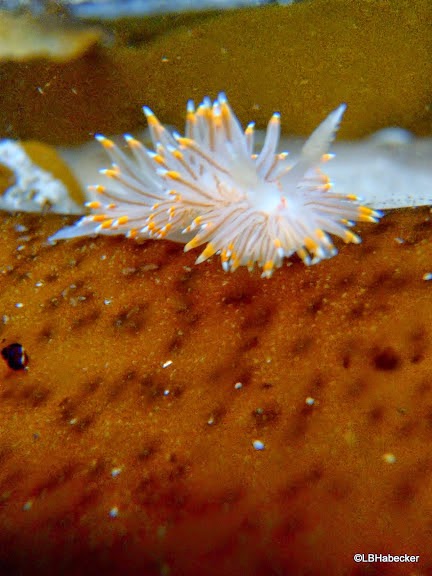May 12th - May 18th 2014
Daily Low Tides
Monday, May 12th
2.1' @ 5:39 PM
Tuesday, May 13th
-0.2' @ 6:33 AM
Wednesday, May 14th
-0.6' @ 7:15 AM
Thursday, May 15th
-0.9' @ 7:56 AM
Friday, May 16th
-1.1' @ 8:39 AM
Saturday, May 17th
-1.1' @ 9.24 AM
Sunday, May 18th
-0.9' @ 10:10 AM
Notes from the week
Monday was an evening low tide; the rest of the week featured great negative tides in the morning, with the lowest of -1.1' on both Friday and Saturday. The weather was great for most of the week, with lots of sun during the week and some overcast skies during the weekend.
It was an active week for bird watching, with lots of mating and nest building! The bald eagles were busy hunting ... successfully, with multiple appearances on multiple days. Guillemots and Gulls were mating and nest building!
Pigeon Guillemots make an appearance (Photo by Susan Glarum)
Brown Pelicans - On the Rocks! (Photo by Lisa Habecker)
The highest visitor count for the week was on Thursday with 168 visitors, followed closely by Friday with 154 visitors!
Wednesday, May 14th
-0.6' @ 7:15 AM
Thursday, May 15th
-0.9' @ 7:56 AM
Friday, May 16th
-1.1' @ 8:39 AM
Saturday, May 17th
-1.1' @ 9.24 AM
Sunday, May 18th
-0.9' @ 10:10 AM
Notes from the week
Monday was an evening low tide; the rest of the week featured great negative tides in the morning, with the lowest of -1.1' on both Friday and Saturday. The weather was great for most of the week, with lots of sun during the week and some overcast skies during the weekend.
It was an active week for bird watching, with lots of mating and nest building! The bald eagles were busy hunting ... successfully, with multiple appearances on multiple days. Guillemots and Gulls were mating and nest building!
A Bald Eagle snags it's prey! (Photo by Susan Glarum)
Pigeon Guillemots make an appearance (Photo by Susan Glarum)
Brown Pelicans - On the Rocks! (Photo by Lisa Habecker)
There were school group visits aplenty this week - both planned and unscheduled. There were 5 scheduled groups and 2 unscheduled groups, with 4 of the groups on the beach on Friday. The school groups on Thursday were treated to an Aquaria station for an up-close look at creatures from the intertidal! The groups ranged from 5th grade to college with a total group visitor count of 291 between Wednesday and Friday.
Aquaria Station (Photo by Susan Glarum)
The highest visitor count for the week was on Thursday with 168 visitors, followed closely by Friday with 154 visitors!
Creature Highlights
Birds
Nudibranch Photos from the Intertidal
Birds
- Bald Eagle (Haliaeetus leucocephalus) - Bald eagles made multiple appearances this week. On Monday, a bald eagle sat on a cormorant nest of the north face and appeared to be eating an egg. Later in the week, A juvenile was spotted terrorizing a pelagic cormorant near the cave; the cormorant left and the eagle sat on the nest and adults were seen hunting for murre. On Saturday, bald eagles made 5 visits! On Sunday, the bald eagles were hunting again with at least 6 incursions and may have taken a Tufted Puffin.
- Turkey Vultures (Carthartes aura)
- Black Oystercatchers (Haematopus bachmani) - Oystercatchers were spotted mating on Monday. An Oystercatcher appears to be making a nest in the saddle.
- Brown Pelicans (Pelecanus occidentalis)
- Western Gull (Larus occidentalis) - Eight gulls fought over herring that was most likely fishing bait; in the end they dropped it on the beach!
- Pigeon Guillemots (Cepphus columba)
Invertebrates
- Red Rock Crab (Cancer productus) - An adult crab was spotted again this week.
- Shaggy Mouse Nudibranch (Aeolidia papillosa) - This nudibranch gets its common name due to its shape and its numerous flattened cerata that makes it look like a bedraggled mouse. It is sometimes called a shag rug nudibranch.
- Opalescent Nudibranch (Hermissenda crassicornis) - This nudibranch can be found from Alaska to Mexico; It can be found in various habitats, including the intertidal zone of rocky shores, but also in bays and estuaries.
- Janolus Nudibranch (Janolus fuscus) - They are semi-translucent and the body is covered in short cerata. The color or the cerata varies according to species; in Janolus fuscus the cerata are orange and white tipped, whereas in Janolus barbarensis they are orange and blue tipped.
- Rufus Tipped Nudibranch (Acanthodoris nanaimoensis) - Growing only to a little over one inch, this species can be found in rocky areas from the low intertidal to water 33 feet deep. It feeds on bryozoans and colonial ascidians.
- Genus Dendronotus Nudibranch - Resides in the North Pacific as far south as California.
- Red Nudibranch (Rostanga pulchra) - The Rostanga can grow up to 30 mm in length and are found intertidally under boulders and in shallow water, commonly feeding on intertidal sponges.
- Trilineata Nudibranch (Flabellina trilineata) - This nudibranch has three longitudinal white lines on its body, as the name suggests. The cerata are red with white tips.
Nudibranch Photos from the Intertidal
Janolus Nudibranch (Photo by Jenee Pearce)
Janolus Nudibranch (Photo by Lisa Habecker)
Red Nudibranch (Photo by Lisa Habecker)
Trilineata Nudibranch (Photo by Jenee Pearce)
Genus Dendronotus Nudibranch (Photo by Lisa Habecker)












Comments
Post a Comment